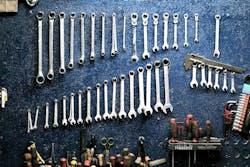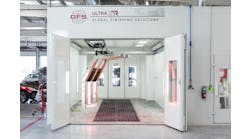By Jason Garfoot, Global Finishing Solutions
Over the past few years, new forms of infrared (IR) technology have taken the industry by storm due to their ability to dramatically reduce curing times. However, IR technology is not just limited to curing paint; it can be incorporated into many stages of the shop process to significantly increase throughput. And with the availability of mobile systems, IR technology can be easily incorporated into shop processes without having to make changes to existing equipment.How IR Technology WorksToday’s IR systems are either gas-fired or electric, both of which offer significant advantages over the IR technology used in collision shops in the late ‘80s. However, the two types of systems differ in the way they generate and maintain heat, which results in differences in quality, speed and ease of use. Newer short wave electric IR systems, such as REVO Accelerated Curing Systems by Global Finishing Solutions, operate by sending an electrical current to a tungsten filament, which then produces mostly short wave energy. The short wave energy is able to penetrate multiple layers of fillers and coatings to heat the substrate underneath, curing from the inside out, while the medium waves help cure the top layer. REVO’s lamps can completely cure multiple layers of each coating in just one curing cycle per coating.
On the other hand, gas-powered systems rely on the flow of natural gas through a catalytic ceramic plate. This produces mostly medium and long waves, curing fillers and coatings from the outside in, and requiring multiple cycles of the system to cure each layer of coating individually. Proper film thickness is critical with these systems or solvent popping and shrinkage issues will occur.Types of Mobile IR SystemsMobile infrared systems range from small handheld units for quick spot curing to larger, dual-cassette systems on wheels designed for full-panel repairs. The single-cassette and dual-cassette mobile IR systems feature heavy-duty wheels, so they can be easily moved in and out of your paint booths and prep areas, and around your shop to wherever you need them. Since they are easy to move around, shops also may be able to use one mobile IR curing system for multiple purposes, increasing ROI. Some systems, such as GFS’ REVO Rapid MC2, feature independently controlled cassettes with separate sensors, allowing the technician to cure two different vehicles or panels with different substrates at the same time.
Using Mobile IR with Repair ProcessesInfrared systems offer standard curing benefits on all products, from body filler to clear coat. Although IR systems are best known for time savings and quality improvements in painting processes, we have found over the past few years that IR systems can have a significant impact on shop throughput and quality when implemented in your repair processes. One of the repair processes that can be improved with IR is curing body filler. Traditionally, technicians have to wait 15 to 20 minutes for body filler to dry before they can begin sanding it. With electric IR systems, curing time is reduced to only a minute or two. While this may not seem like much time, the savings add up when you’re filling multiple panels each day, or working on complicated repairs that require multiple filler applications. It also enables the technician to move on to priming faster.
The repair process that can be the most improved by implementing IR technology is priming. Primer surfacer normally takes hours to dry, but this can be cut down to just minutes with short wave IR. Since primer takes a significant amount of time to dry, it has become commonplace for high-production shops to prime all of the vehicles at the end of the day, so they can dry overnight and be sanded in the morning. Since it’s possible to sand all the way through the primer, requiring the vehicle or part to be reprimed and sit to dry a second time, technicians often put on too much primer. This can create quality issues like shrinkage, which can lead to edge mapping. When primer is over-applied, the top layer dries first, and solvent gets trapped underneath the other layers of primer. The sanding process opens up that primer, allowing the solvent to be slowly released and the primer to shrink. After a couple of weeks, the repaired area sticks out like a sore thumb. This can lead to costly rework and lower CSI scores.Using an electric IR system with primer can remedy all of these issues, as well as reduce the drying process from two to four hours (or overnight) to around 11 minutes. As soon as the part cools down, you can begin sanding the primer. Even if the primer was over-applied, the short wave energy will reach the substrate underneath, fully curing the primer from the inside out, resulting in primer that is 100 percent cured and will never shrink.
Mobile systems are especially useful for curing filler and primer, as they can be easily moved to the vehicle or panel needing to be cured, as opposed to needing to move the vehicle or part into a designated prep area, saving time. With the use of roll-on primer, primer can be applied and cured with mobile IR systems on the shop floor, freeing up the prep stall to be used just for applying and curing paint. Curing Paint with Mobile IRWhen it comes to curing paint, IR Systems can be integrated into a paint booth or prep stall for fast curing and easy mobility, or mobile IR systems can be used. Some dual-cassette systems, like GFS’ REVO Rapid, are available as booth-integrated rail systems or mobile systems on a cart with heavy-duty wheels. Both systems operate exactly the same; it is the way they move around a booth or prep area that differs.
While the rail-mounted systems move easily around the booth, the mobile systems offer the flexibility of moving between booths, as well as to other locations in the shops for other curing processes. Mobile IR units are also faster to implement into your paint curing process as they do not require integration into the booth ceiling. Whether you use a rail-mounted or mobile system, electric IR technology can dramatically reduce curing times for any kind of paint and is an excellent complement to your paint booth’s curing mode. Since the average repair involves just one to four panels, they do not require the full booth airflow to cure the paint job. You can save significant energy by using the curing mode of the booth for full vehicle paint jobs and using electric IR for curing multiple parts or panels. More than just CuringIn addition to curing filler and coatings, mobile IR units can be used in a variety of other ways to improve shop processes. Easily and efficiently remove dents on bumpers with mobile IR single-cassette or handheld units. The infrared waves heat up the plastic in seconds, softening it so the dent can be easily pushed out. When heated, plastic returns to its original shape. We’ve even seen the single-cassette REVO Spot unit push the dent out all on its own. Since electric IR produces short waves to penetrate directly to the substrate, mobile IR units can also be used effectively to heat up adhesives to easily remove vinyl graphics, decals, emblems or body side moldings. Other uses of mobile IR include softening glass seals, plastic part repair and bumper sweating.
Regardless of how you use mobile IR, this technology can have a significant impact on improving your shop’s productivity, efficiency and throughput. By streamlining your shop processes, your shop flow becomes more predictable and economical. Start small by testing out a handheld IR unit like the REVO Handheld or a single-cassette unit such as the REVO Spot, and you will soon see how this technology can revolutionize your shop.
Latest in Global Finishing Solutions
Latest in Global Finishing Solutions



